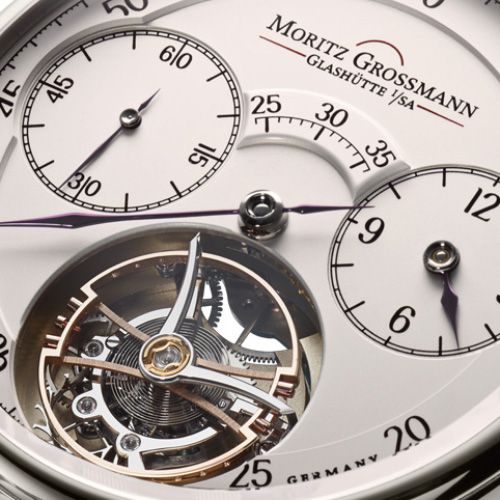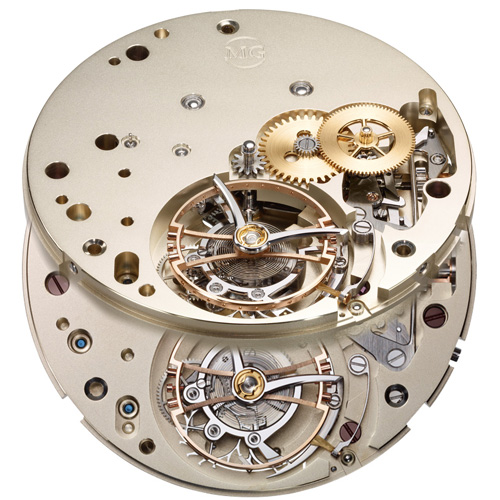Moritz Grossmann presents the first manufacture calibre with a tourbillon – the third-generation BENU
In 2010, the name BENU saluted the impressive genesis of the MORITZ GROSSMANN GLASHÜTTE I/SA brand. As the young manufacture's first manually wound watch, the BENU embodies the horological precision of Moritz Grossmann, the elegance of his timekeeping instruments, and conceptual aspirations of the watchmakers at Grossmann in the 21st century. Their ambition is to meld micromechanical ingenuity and traditional artisanship with latest-generation technology in the form of exclusive masterpieces that epitomise high-end watchmaking.
The appearance of the BENU Tourbillon reflects the lineage of its model line. Its slender three-part case in 750/000 white gold tapers out along the gently curved strap lugs. The elegant narrow bezel directs the focus on the crisp displays and the aperture for the unusually large Grossmann three-minute tourbillon. The three-part solid-silver dial has a symmetric face. To make the decorative element of the tourbillon at 6 o'clock consistent with the accurate legibility of a precision timepiece, the seconds and hours are displayed on two recessed, off-centre subsidiary dials. Their manually crafted hands have distinctively different shapes. The hour hand, in keeping with its function, is more prominent to assure unambiguous readings of the time.
The instrument-like appearance of the BENU Tourbillon is emphasised by the refraction of the crisp minute scale in the chamfer of the sapphire crystal. The time range from 25 to 35 minutes, which is interrupted by the tourbillon aperture, is precisely readable thanks to a rearward extension of the minute hand that sweeps the scale arc on the opposite side. A patent application has been filed for this dual minute display arrangement. Endowed with easily legible Arabic numerals and wispy-tipped, filigreed hands crafted in-house, the BENU Tourbillon stands out like a prime example of the aesthetic 19th-century precision measuring instruments for which Glashütte was acclaimed.
In particular, the BENU Tourbillon is characterised by the following new developments:
- The Grossmann three-minute tourbillon according to Alfred Helwig
- The flying tourbillon cage with a V-shaped balance cock for which a design patent is pending
- The patent-pending stop seconds with a fine-hair brush
- The asymmetric-arm lever escapement
- The new configuration of the Grossmann balance and hairspring with an overcoiled terminal curve
- The newly developed mainspring barrel jewel bearing
- The brake ring on the fourth-wheel arbor made of guaiacum
- The ARCAP alloy for the going train wheels
- The patent-pending dual minute display with an extension of the minute hand
The Grossmann three-minute tourbillon with stop seconds
Amply dimensioned, the oscillator with the Grossmann balance is integrated in a unilaterally suspended, “flying” tourbillon cage according to Alfred Helwig (1886-1974). The famous watchmaker strongly influenced the evolution of Glashütte as a stronghold of German watchmaking. Alfred Helwig was a teacher at the German School of Watchmaking from 1913 to 1954; in 1920, he applied for a patent for the flying tourbillon. In 1922, he earned his master craftsman's credentials with a unilaterally suspended five-minute tourbillon. Originally, the tourbillon served the purpose of offsetting gravity-induced rate deviations in pocket watches that were worn vertically. Today, a well-formed tourbillon ranks among the genuine challenges for master watchmakers. As the author of the book entitled “Drehganguhren”, Alfred Helwig was a source of inspiration for Grossmann's calibre designers while they were developing their three-minute tourbillon.
The tourbillon cage is freely suspended from a cantilevered, hand-engraved cock made of German silver. Its design is totally new, resulting in a distinctive manifestation of functional purity. The novel configuration of the tourbillon, which has an unusually large diameter of 16 mm, is beautifully showcased with a longer periodicity. Elaborately crafted, the upper part of the cage is a V-shaped balance bridge that requires only two posts, a significant hallmark for which a design patent has been registered.
The lavish execution of the cage with two triangular posts is a prerequisite for an additional complication. For the watchmakers at Grossmann, the ability to accurately set the time is a crucial precision requirement for a tourbillon mechanism. To reliably immobilise the balance, the stop device must bypass the cage frame posts. An elastic human-hair brush can easily glide past the triangular posts and gently brake the balance at the circumference of its rim. The patent-pending stop-seconds solution completes this impressive implementation of a Grossmann timekeeping instrument (the patent application is endorsed by SIGNO, an initiative of the German Federal Ministry of Economics and Technology).
A modified Glashütte stopwork secures the tension of the mainspring. After winding, it allows the ratchet wheel to reverse somewhat and slightly relax the mainspring. The stop click is firmly secured with the addition of a steel cover.
To reduce the kinetic energy of the tourbillon and the exposure of the lever escapement to stress, the periodicity of the cage was extended to three minutes with an additional wheel.
The pinion for the seconds is segregated from the power flow of the wheel train and driven with reduced torque. To prevent arbor and seconds-hand backlash, the pinion is constantly braked by a spring. Grossmann's watchmakers designed this function in a sustainable and maintenance-free manner by choosing guaiacum spp., an oily wood species, for the brake ring of the fourth-wheel arbor. It is classified as “rock-hard” and has good long-term tribological properties. This solution was inspired by the extremely dependable marine and tower clocks that John Harrison (1693-1776) crafted with great success in the 18th century. As a master carpenter, Harrison accrued considerable experience with various types of woods, especially the very durable ones he selected for his marine chronometers.
Grossmann's contemporary precision timepieces stand for HERITAGE IN TIME beyond our era. It was also a key objective to preserve the beauty of the wheel train of the BENU Tourbillon, with its precious decorations and polishes, by precluding oxidation and damage to coated surfaces. The train wheels are made of ARCAP, a copper-nickel-zinc alloy coveted for its long-lasting brilliance. Crafted from beryllium bronze, the balance has a stately presence above the silvery going train.
The hallmarks of the Moritz Grossmann brand
The BENU Tourbillon also unites the traditional characteristics of Grossmann-style horological prowess with modern watchmaking elements and the typical features of the new brand:
- Pillar movement with 2/3 plate and frame pillars in untreated German silver
- Hand-engraved 2/3 plate and tourbillon cock
- Wide horizontal Glashütte ribbing on the 2/3 plate
- Modified Glashütte stopwork with backlash
- Separately removable clutch winder
- Raised gold chatons with pan-head screws
- Screws annealed to brown-violet
- White sapphire bearing jewels
- 3-band snailing on the ratchet wheel
- Manually crafted steel hands, annealed to brown-violet






Movement Manufacture calibre 103.0, manually wound, adjusted in five positions
No. of parts 245 (wheel train 186, cage 59)
No. of jewels 30, 4 of which in screwed gold chatons (wheel train 17, cage 13)
Escapement Lever escapement
Oscillator Grossmann three-minute tourbillon with stop seconds; shock-absorbed Grossmann balance with 4 inertia and 2 poising screws, suspended Nivarox 1 balance spring with No. 80 terminal curve, Gerstenberger geometry
Cage diameter 16.2 mm
Cage speed 1 revolution in three minutes, anti-clockwise when viewed from dial side
Balance diameter 14.2 mm, frequency 18,000 semi-oscillations per hour
Power reserve 72 hours when fully wound
Functions / features
- Flying three-minute tourbillon with screw-secured driving wheel and V-shaped balance bridge (design patent pending)
- Sweep minutes, off-centre hours and seconds with stop seconds, replacement of the missing minute scale segment from 25 to 35 minutes with a separate scale swept by the extension of the minute hand on the opposite side (patent pending)
- Stop seconds at the balance wheel rim with a pivoting fine-hair brush (patent pending)
- Asymmetric-arm lever escapement with counterweight and lever banking pin
- Grossmann balance with suspended balance spring, adjustable with poising screws in the rim
- Newly developed mainspring barrel jewel bearing
- Brake ring on the fourth-wheel arbor made of very hard, oily guaiacum
- ARCAP train wheels
- Grossmann winder with pusher to deactivate the handsetting mode and start the movement
- Modified Glashütte stopwork with backlash
- Pillar movement with 2/3 plate and frame pillars in untreated German silver
- Hand-engraved 2/3 plate and tourbillon cock
- Broad horizontal Glashütte ribbing
- 3-band snailing on the ratchet wheel
- Raised gold chatons with pan-head screws
- White sapphire bearing jewels
- Separately removable clutch winder
Operating elements Crown in 750/000 white gold to wind the watch and set the time, pusher in 750/000 white gold to start the movement
Case dimensions Diameter: 44.5 mm, height: 13.8 mm
Movement dimensions Diameter: 38.4 mm, height: 7.1 mm
Case Three-part, in 750/000 white gold
Dial Solid silver, three-part, argenté, with Arabic numerals
Hands Hand-crafted, steel, annealed to a brown-violet hue
Crystal/display back Sapphire crystal, antireflective coating on one side
Strap Hand-stitched alligator strap with butterfly clasp in 750/000 white gold
Ref.: 001.G-221-11-1
Price: EUR 168,000 (suggested retail price for Germany)




